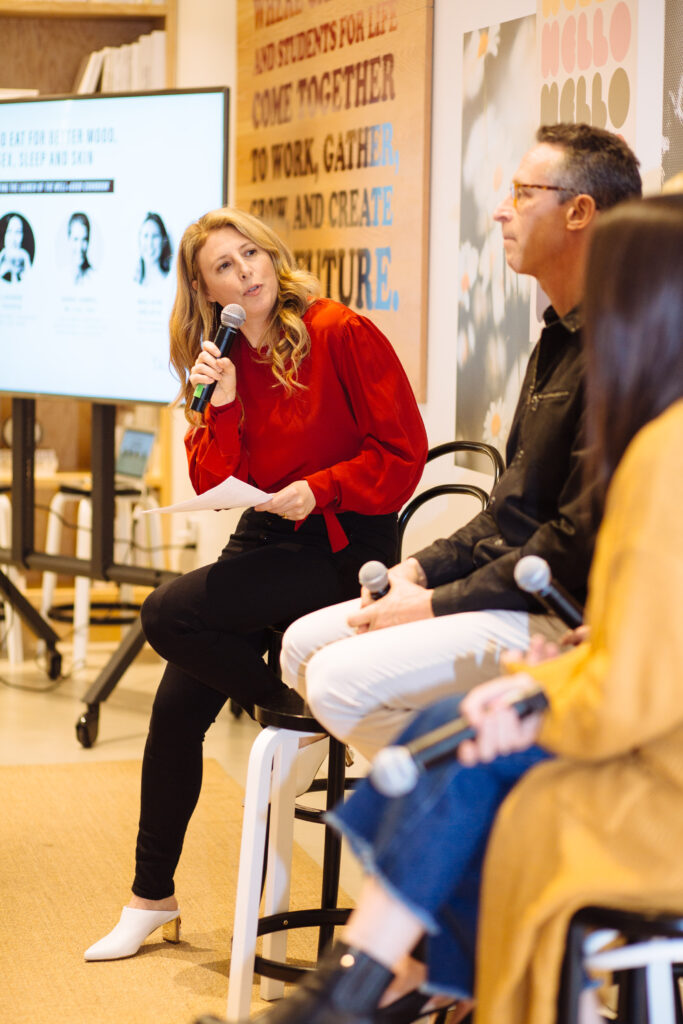

In this edition of the Wellness Q&A Series Beth McGroarty, VP, Research & Forecasting, Global Wellness Institute asks:
Has COVID-19 fundamentally changed people’s concept of “wellness”?
What wellness markets will grow fastest in the future?
What do the successful wellness brands of the future look like?
Will the new conversations around racial inequality in wellness impact the industry long term?
Q&A with Melisse Gelula, co-founder of Well+Good, a pioneering digital media company

Melisse Gelula was named one of 9 Most Creative Entrepreneurs by Inc magazine and one of 10 Writers and Editors Who Are Changing the National Conversation by Adweek. She has shared her expertise with Good Morning America, CBS This Morning, the New York Times, WSJ, Fast Company, and more. Having grown her company to a successful acquisition, Melisse now advises mission-driven wellness brands in tech, beauty and more. Previously, she worked in mental health as a psychoanalytic therapist and crisis counselor. She is a Global Wellness Institute Board Advisor and recently contributed to the organization’s white paper Mental Resilience in a Time of Stress and Trauma. Currently, Melisse is researching midlife psychosis and motherhood for her forthcoming book, a memoir about being raised by a mother who lived with untreated schizophrenia.
VP, Research & Forecasting, GWI, Beth McGroarty: Has COVID-19 shaken up people’s concept of wellness? If so, how?
Melisse Gelula: Pre-COVID, wellness was increasingly associated with very consumer-y trends—the $17 organic salads, $60 collagen supplements, and the $150 leggings. It was increasingly seen as being a very elitist and privileged industry. But when the pandemic hit, all of us, everywhere, suddenly found ourselves facing something huge and serious: We desperately needed things in our everyday lives to help fortify our health, our sanity, our communities, and our homes. Overnight, people woke up to the importance of more real, accessible wellness for themselves and their families. And this crisis has been a wellness wake-up call for people who may not have been open to it before.
“Pre-COVID, wellness was increasingly associated with very elitist, consumer-y trends—the $17 organic salads, the $150 leggings. With the pandemic, wellness instantly became more vital in a Maslow’s hierarchy of needs kind of way. The word “wellness” will lose some of its stigma.”
Many of us have been arguing forever that wellness is a lifestyle; many of us have been fighting for the idea that wellness needs to be more accessible to all. This crisis has provided proof for that in ways that everyone can understand. Wellness has become more vital in a Maslow’s hierarchy of needs kind of way. So, I see the word “wellness” losing some of its stigma. And if health and wellness once occupied separate channels, now I see them—happily—coming closer together.
During the pandemic, we’ve seen people rushing to proven, beneficial wellness practices that cost little or nothing: learning or practicing meditation or getting out in nature and walking. There’s much data that shows the ways that people worldwide are restructuring their lives around wellbeing practices. For instance, Pinterest released amazing data around their search terms in the middle of the pandemic (February to May 2020), and they saw record searches around mental wellness concepts, with meditation up 44%, gratitude up 60%, and positivity up 42%. Searches around bringing wellness into the home, stress relief, and exercise all saw huge gains. A host of self-care and wellbeing practices suddenly became the coping strategy for more people in the new normal.
GWI: You’re now advising a number of wellness start-ups and are deep in how investment and the market are changing. What categories in wellness do you see growing fastest and mattering most in the future?
“Solving for mental health and wellness will be the biggest future opportunity in the industry.”
Gelula: Yes, I’ve started advising mostly female-founded, first-time entrepreneurs in the wellness space, and most are digital brands that have come up during the pandemic to solve real problems—and our world has a lot of them. This is very interesting to me because building and marketing another kombucha or protein bar brand is not a real problem to solve.

Solving for mental health and wellness will be the biggest future need and opportunity. A recent study by JAMA found that depression rates have tripled for Americans during the pandemic. And yet, mental health is simply the most bewildering, overlooked area in healthcare (and I was a psychoanalyst-in-training and saw people in deep crisis for many years): It’s hard for even really high-functioning people to find a therapist or figure out how to pay for one. It’s funny, all the wellness from “our neck up”—much of our therapy, our mindfulness, even our eye care—is largely privatized and out-of-pocket. It’s been so difficult, but with a massive mental wellness crisis underway, this can no longer be a luxury; it needs to be an essential service.
There’s so much innovation going on in teletherapy and with digital mental wellness platforms, with more funding flowing into this space in 2020 than for any wellness sector. Digital is going to be a far more affordable and democratizing play for the mental health and inner life space, and we will see many revolutionary ideas coming to our devices that shake up how mental health services get delivered. Many of the great ideas will come from outside the traditional mental health industry, and entrepreneurs and practitioners will come into the market without ever having had a brick and mortar business. Some of the newly emerging companies I’m working with are creating more relevant mental wellness platforms for Gen Z and the younger generations. We will also see companies many of us are familiar with coming out with new products that make mental health/wellness more accessible in the next six months.
It’s interesting and telling that even social media platforms, spurred by the pandemic, are now grabbing the mental wellness wheel. There have been a bunch of synergistic partnerships: Snapchat has launched new tools and content around mental wellness and has partnered with Headspace to deliver meditation and mindfulness. Pinterest has created emotional health resources, pins and content, partnering with the Stanford Lab for Mental Health Innovation. These mental wellness moves from social media companies are helping them reach the loneliest, most depressed and anxious generation: the young.
There is so much to say, to rethink, and to invent around mental health and wellness. This is why I’m now writing a book on the topic (framed as a memoir), as I had a mother with schizoaffective disorder who experienced hallucinations and severe mental health challenges. It’s something I’ve never talked about publicly, but this is the conversation our world needs most now and the most important space in wellness.
“A sea change is coming to corporate leadership and career and workplace wellness.”
Another area that will go through a sea change is corporate leadership and career and workplace wellness. We were already facing an employee burnout and mental wellness crisis pre-pandemic. And now employees are radically more overwhelmed: financially, fearing for their safety, and with people thrust into working from home, they’re crushed by juggling family and their jobs, with a fast-dissolving boundary between life and work. It’s so bizarre: It’s as if we’re returning to a time before the Industrial Revolution when all commerce came out of people’s homes and property, but now it’s digital work with an always-on mindset. I’m hearing scary stories: Companies saying, well now that you don’t have commute time, we will start work and meetings at 7:30 AM.
This is impacting everyone, it’s infuriating, and companies (not just employees) are going to have to set real boundaries. For ages, companies drew a hard line (9 to 5) when it came to their role in employees’ lives, and they wouldn’t get into or support, say, their mental health issues because that’s “too personal.” We’ve had to drag companies into offering things like paid leave and mental health days. But companies never seem to mind if their work keeps encroaching further and further into all hours of our lives.
The pandemic is accelerating how frustrated people are with how work is taking over our lives and with the lack of opportunity in the job market (and this is especially true of millennials). I think we will go through a corporate culture and conscious leadership revolution, and it will become crystal-clear who’s caring for their employees and who’s not. More companies will adopt a really human-focused and solutions-oriented mindset, with the rise in a more conscious, empathetic style of leadership that not only helps people feel safe but motivated, supported and actually cared for. If we don’t have this leadership sea change now, it will cripple the workforce. A lot of conscious leadership programs, tools and apps are now coming to the fore. (I just did a program created at Google that focuses on emotional intelligence.) And new approaches to workplace wellness and corporate leadership will be very important for all industries and an opportunity for the wellness market.

GWI: The Black Lives Matter movement has shined a more pitiless spotlight on racial inequities in access to both healthcare and wellness, exposing how white and elitist the wellness market can be. Do you think these new conversations will impact the wellness industry in the long term?
Gelula: First, it’s fantastic to see so many wellness brands by people of color finally getting recognition. But I feel that there has been a lot of pretending in the wider wellness space that equality has been addressed and that they don’t really need to be part of any solution. Every company needs to be part of a solution and seek real equality because wellness is now increasingly political, whether you want it to be or not. Every wellness company needs to make sure that the experiences and brands they create are highly inclusive, whether for people of color, aging people, or LGBTQ consumers. They have to ask themselves the hard questions about the mix of their executive teams and have honest conversations with people of diverse populations on their teams about how they could make their offerings and their company more authentically inclusive.
“It’s not acceptable to NOT take a stance on diversity now. Diverse wellness brands will now grab the limelight, and those seen as failing on this will increasingly receive blowback. There’s a lot of un-following going on.”
It’s not acceptable to NOT take a stance on diversity now. I predict diverse brands will now also grab the limelight, and those seen as failing on this will increasingly receive blowback. People—especially young generations—are savvy and get turned off by tone deafness or lack of real acknowledgment of Black Lives Matter by companies; there’s a lot of un-following going on.
It’s all part of the great transitional moment we are in right now, and so many positive things could come from it. I think we will see it from an eagle-eye perspective in a few years: More companies will have moved from a narrow profit-focused model to a human-focused model in business. Companies that can roll with that will be the ones consumers believe in and buy from and that employees commit to. Eric Weisberg recently argued in Fast Company that the experience of the pandemic means that every brand now needs to behave like a health or wellness brand. This includes wellness brands not walking the talk. It means showing empathy and really relating to the needs and pain-points of your customers (and your employees, I’d add)—and right now, that means respecting their wallets, given the devastating economic situation. Tom’s donated a pair of shoes with each shoe purchase for years. We’re going to see more giveback and pay it forward models like this.

GWI: Any last thoughts on any big picture changes you see coming to the wellness market?
Gelula: The brands that solve real problems will succeed, and we have a whole lot more big problems to solve. Companies that just “sell stuff” and the things that people used to gravitate toward on Instagram (peddled by all those lifestyle influencers) are fading fast. Wellness is no longer a nice to have; it’s a need to have for people, and wellness brands have a huge opportunity to show up and tackle actual needs. We will see more companies and products that are really essential services—whether in mental wellness, in work solutions, in healthy food. The future of the wellness market is a new kind of problem-solving: More solutions-minded wellness businesses that can reach far more people.
It’s a “get real” moment, and all of a sudden, there is more discussion, innovation and investment in what were once stigmatized categories. For instance, in the healthcare tech space, I’m working with a brand called Poppy Seed Health that is solving for unmet maternal health needs (and the high maternal death rate in the US, especially for women of color) by connecting women 24/7 via text to nurses, midwives and doulas, and which also has a miscarriage community for women to talk about this painful topic openly. In beauty, I’m working with a company that is designing products for Indian women and their complexion concerns, a market that has never been addressed.
There are so many gaps in our healthcare system, in our mental health system, in the work/career space, even in beauty that wellness is seeking to fill, and digital companies can play a huge role. But digital companies or not, this is a massive opportunity for wellness to really step up—and act more responsibly—as an industry. And that’s truly exciting.
We want to hear from you
Do you think COVID-19 is changing people’s concept of wellness? And will conversations about racial inequality in wellness impact the industry long term?

























































COVID has dramatically changed wellness and all it stands for as we close out 2020. Not just in USA, but in Canada, Europe, Australia, Africa and more, We would never have dreamed the reality that is today, would we? Travel to tourism and hospitality completely decimated world-wide, making a wellness focused holiday or getaway for a few days simply out of the question. And by the way? Any type of break from routine is a ‘holiday’ which we have longed profiled as wellness, for your wellbeing.
How about if we refocus our efforts on all age brackets – not just youth or younger audiences 45-, because let us not forget, those of us 55+ have the same needs. Everything the new generation is going through we had to go through in silence plus we are continually paving the way of what is to come for those under us. So let’s take care of all the people, across the diverse cultures, colours of skin, and mental/physical age. Thank you for the tremendous work each of you is doing. It is needed so very much. The articles are always a good read which helps to keep us informed and perhaps catch those falling through the cracks. Deeply appreciated. Stay well, friends.
Great article – agree with much of it. Also see retailers still stuck in the old way of thinking. A few yrs ago, we released a functional food snack aimed at brain health named Wholly Noggin which is slowly gaining attention.
Wonderful to wake up and read this interesting and inspiring interview…thanks everyone1
Comment intended for the Q&A with Melisse Gelula, co-founder of Well+Good, a pioneering digital media company
Regrettably, it may be true that “Pre-COVID, wellness was increasingly associated with very consumer-y trends—the $17 organic salads, $60 collagen supplements, and the $150 leggings. It was increasingly seen as being a very elitist and privileged industry.” If the pandemic has any long lasting benefits, and horrific events always do (which of course is not to suggest anyone should welcome such), I hope a better understanding of wellness will be one of them, especially if it means more people get wise to the frivolity of conspicuous and wasteful consumption disguised as wellness.
Please, get it straight. Wellness was never meant as a brand, a treatment or a service. It’s a concept or philosophy about a process or style of functioning consistent with optimal wellbeing consistent with one’s potentials. At its best, it’s focused on positive experiences and outcomes. A REAL wellness model of the concept assures that there can be no confusion about ersatz wellness, such as illustrated in the first two sentences. This is the case because the dimensions of REAL wellness are reason (i.e., critical thinking, respect for evidence and science), exuberance (love of life, joy and happiness, meaning and purpose), athleticism (nutrition and exercise) and liberty (realizing personal freedoms of thought and behavior in order to live the kind of life you want).
Not much there for the likes of Goop.